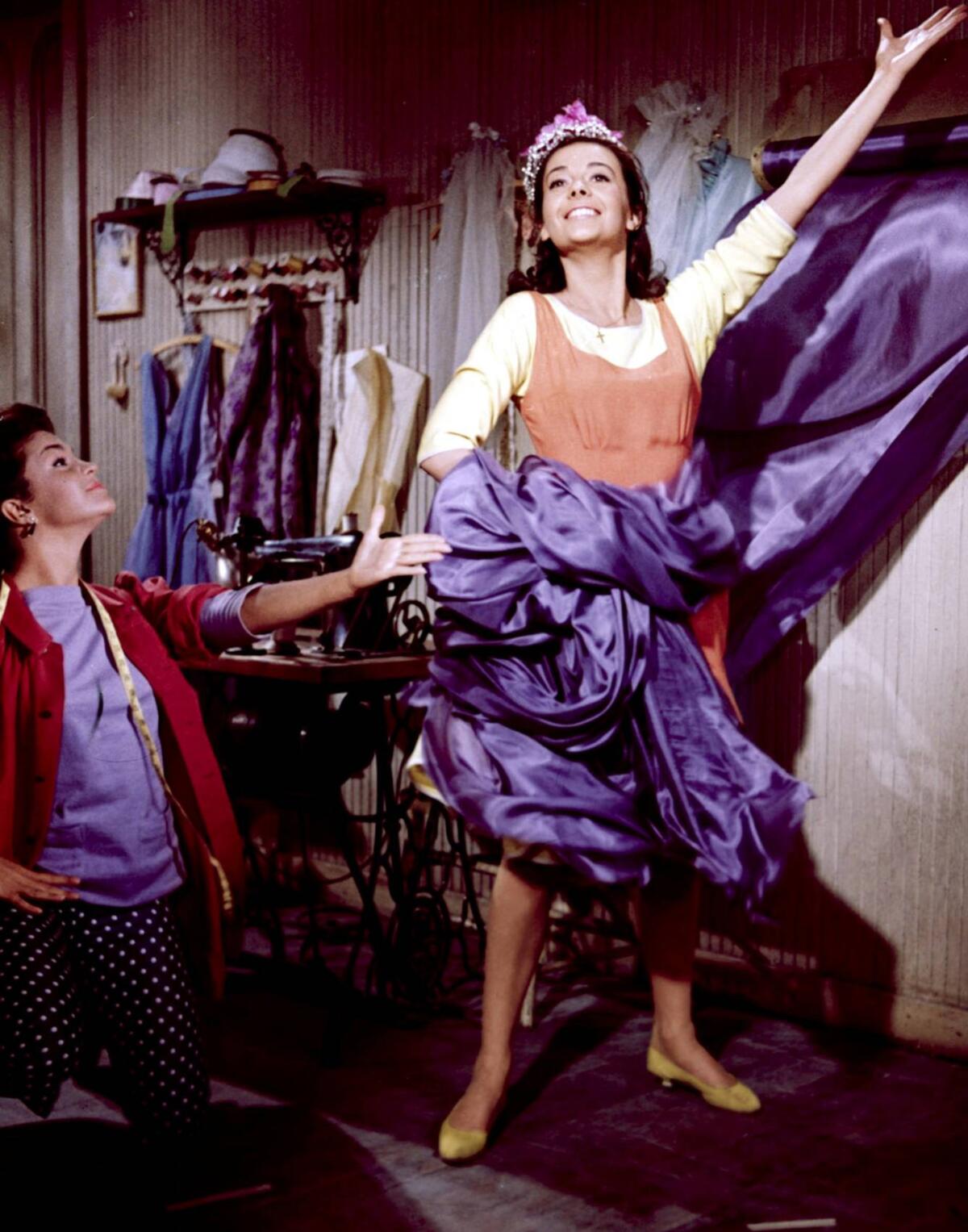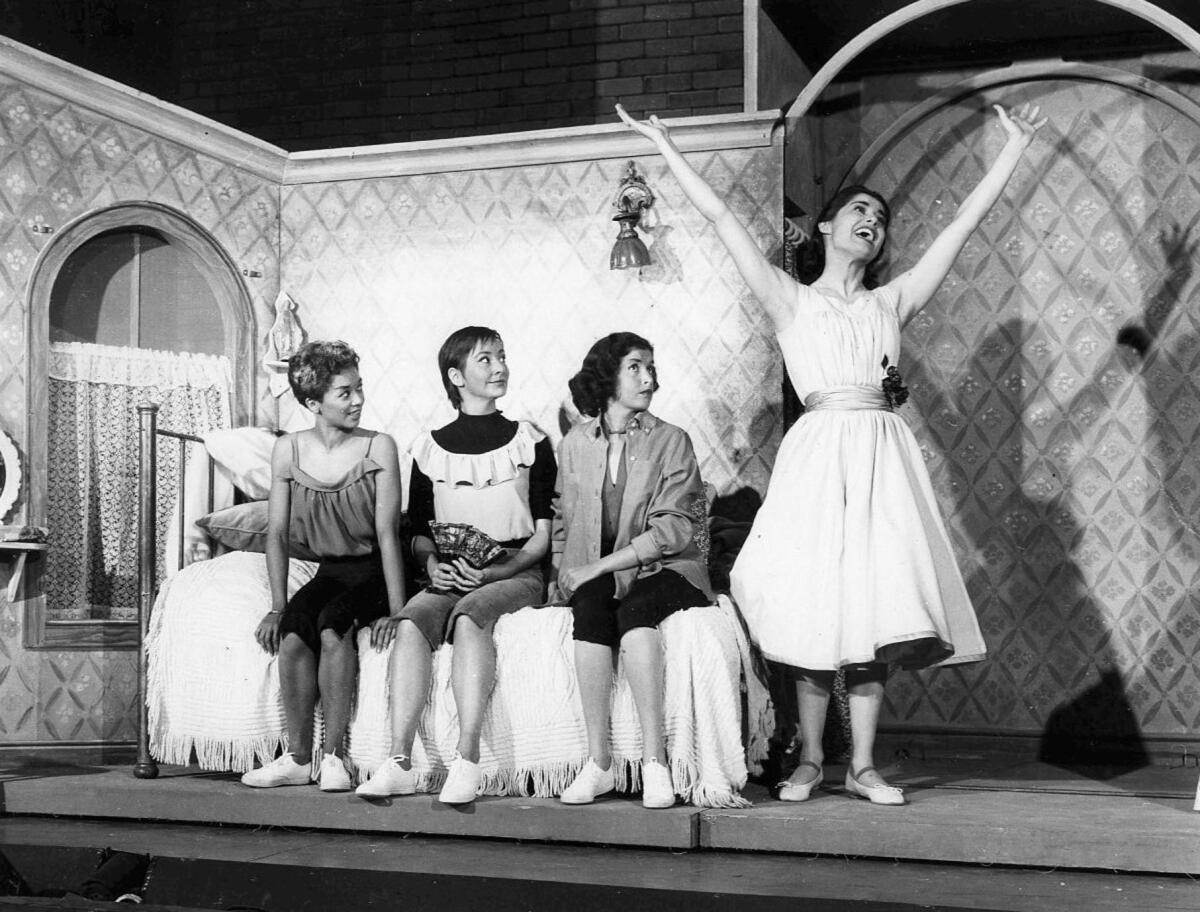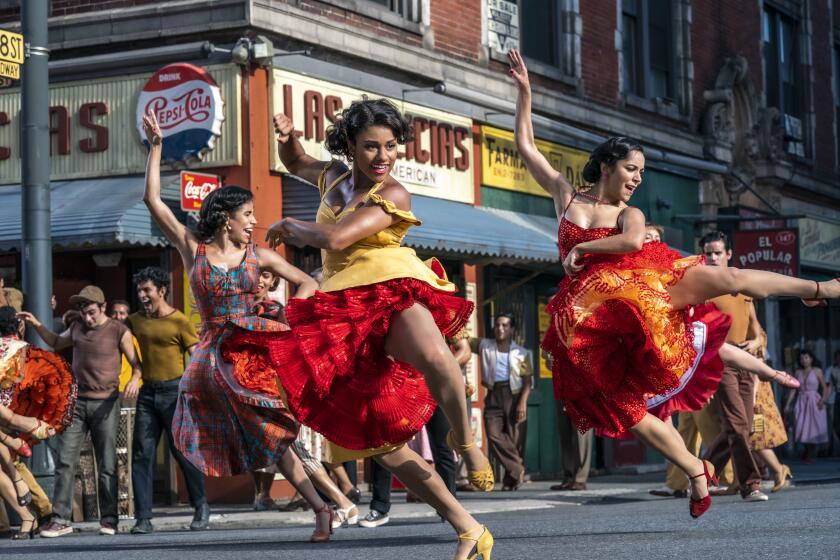How Steven Spielberg’s ‘West Side Story’ finally solved the problem of ‘I Feel Pretty’

- Share via
How do you solve a problem like Maria’s “I Feel Pretty” number from “West Side Story”? Stephen Sondheim, who wrote the lyrics for the musical, regretted his sprightly wordplay shortly after the song was put into the show.
At the time, Sondheim, a prodigy in his mid-20s, was still a Broadway novice. He saw himself as a composer-lyricist and was initially reluctant to supply the words to Leonard Bernstein’s music. But the prospect of collaborating with a heavyweight creative team, which also included book writer Arthur Laurents and director-choreographer Jerome Robbins, was an opportunity Sondheim’s mentor, Oscar Hammerstein II, told him he shouldn’t pass up.
In “Finishing the Hat,” the first of his two-volume set of collected lyrics and attendant commentaries, Sondheim recounted how he came to see the flaw in “I Feel Pretty.” After hearing the song at a run-through before the musical’s out-of-town tryout, “Fiddler on the Roof” lyricist Sheldon Harnick pointed out to Sondheim that a line like “It’s alarming how charming I feel” didn’t seem right for a young Puerto Rican woman still struggling with her English. He also noted that the phrase “an advanced state of shock” sounds strained coming from Maria’s friends.
Critics’ reactions, comparisons to the 1961 movie and more to know about the new “West Side Story” starring Ansel Elgort and Rachel Zegler.
Sondheim concurred: “I had been aware myself of this, and that the play on words in ‘pretty wonderful boy’ drew attention to the lyric writer rather than the character, but I had hoped no one would notice anything but the cleverness of it. I was wrong. In an advanced state of shock, I quickly rewrote the lyric to make it simpler and more in keeping with the way Maria and the girls expressed themselves in the rest of the score, but my collaborators would have none of it — they liked it the way it was. And is. I have blushed ever since.”
Not every collaborator was pleased. Arthur Laurents, never one to mince words when he was alive, delivered his stinging verdict on the song in his memoir “Original Story”: “‘I Feel Pretty’ was prototypical Hammerstein and a puzzle. Hardly what a Puerto Rican girl would sing, out of the style of the show, but the audience loved it. They still do and it still doesn’t belong in the show.”
The very question of what does or does not seem appropriate for Maria and the other Puerto Rican characters is itself a matter of controversy. “West Side Story,” a 1957 Broadway classic created by four white Jewish men who were artistic trailblazers, has been criticized for racial stereotyping. For those who have felt demeaned by the representation of Latino culture in a work that transforms Shakespeare’s “Romeo and Juliet” into a musical tale of warring New York City street gangs, the problem with “I Feel Pretty” goes beyond verbal frippery.
In the most recent Broadway revival of “West Side Story,” Ivo van Hove’s kinetic multimedia production that was forced to close early last year because of the COVID-19 pandemic, the number was cut. After years of voicing his misgivings about “I Feel Pretty,” Sondheim feigned that he was broken up over the removal.

But as he explained to “60 Minutes” correspondent Bill Whitaker, he was only kidding. The song’s diction still bothered him, but he also recognized a dramatic problem that had become more conspicuous in a streamlined production performed without an intermission.
In the original musical, “I Feel Pretty” was written to be sung at the start of the second act. The first act ends with the rumble between the Jets and the Sharks that leaves two gang leaders dead. When the curtain rises on the second act, Maria is at home with her girlfriends, unaware that her beloved Tony has killed her brother, Bernardo, after Bernardo killed Tony’s best buddy, Riff.
Sondheim explained to Whitaker that the number, charming as it may be, disrupts the dramatic momentum. The audience, he said, wants to get back to the story, and “if you do ‘I Feel Pretty’ you have a five- to seven-minute wait” before that can happen.
In the 1961 film directed by Robbins and Robert Wise, the song happens before the rumble. It’s also been relocated from Maria’s bedroom to the bridal shop, where she and Anita, Bernardo’s girlfriend, work. The irony of the song is replaced by giddy romanticism. Maria’s friends still don’t know the identity of her love. But an ingenue’s rapturous musical flight isn’t darkened by the audience’s knowledge that two young men have just been needlessly killed. Rather than singing in the wake of a tragedy she has yet to discover, Natalie Wood’s Maria is simply reveling in the ecstasy of love before her teasing friends.
A beloved show tune, “I Feel Pretty” has never lacked for champions. Carol Lawrence, who originated the role of Maria on Broadway, said that she “loved the number,” despite it being Robbins’ “least favorite” in the show, because for him “it dealt with the inane behavior of a young woman in love.” Apart from Bernstein’s “beautiful music,” she said, “It was a fun, wonderful moment” in a show not full of lighthearted scenes.
In her book “Something’s Coming, Something Good: ‘West Side Story’ and the American Imagination,” theater critic Misha Berson mounts a defense for “I Feel Pretty” on two fronts. Bernstein’s melody, she writes, is “right in the Broadway zone, with a Rodgers and Hammerstein ‘I’m in Love With a Wonderful Guy’ zing to it.” As for the lyrics, what comes across “is not Maria’s overreaching vocabulary, but her playful and guileless delight and the easy-on-the-ear sparkle and pop of the rhymes….”

Up to this point, my favorite performance of “I Feel Pretty” was Elaine Stritch’s mordant rendition, which I saw her perform in her 80s at New York’s Cafe Carlyle a few years before she died. But I was mightily impressed with the way Steven Spielberg’s acclaimed new film version of “West Side Story” cracked the dramatic code of the song with ingenious recontextualization.
In Tony Kushner’s screenplay, the scene takes place in Gimbels department store, where Maria and her girlfriends are part of the late-night cleaning crew. Dressed in pink smocks, they frolic among the clothing racks, brandishing dusters and brooms. Maria is vertiginously in love but she’s also swirling in the consumerist spell of an America that has consigned her to a custodial role.
Maria tries on a scarf that’s too costly for her meager salary. The dazzle of the floor displays inspires her to adopt an air of debutante frivolity. Sondheim’s sparkling lyrics, which some find incongruously Cole Porter-ish, are motivated by the pageantry of retail seduction.
Spielberg’s film is grittier than its predecessor. Authenticity is a difficult concept to apply to a work that has New York gang members balletically strolling the streets of Manhattan’s rough-and-tumble West Side. Not all of the attempts to heighten verisimilitude pay off. Cultural stereotypes stubbornly persist. “West Side Story” is perhaps too much of a fable to assume all the communal weight Kushner would like to supply. But a perfect poise between realism and stylization is achieved in the reframing of “I Feel Pretty.”
The limited nature of the employment opportunities available to Maria (an irresistible Rachel Zegler) and her friends is conspicuously in view. But musical theater fantasy doesn’t seem amiss in this wonderland of getting and spending. The choreography leads Maria and her co-workers to take in their reflections in the dressing room mirrors in an imaginative reverie that transports them to a more glamorous somewhere.
Amorousness occasions this momentary break from the grind, but the double reality of Maria’s marginalized life is brought into sharp relief. When tragedy greets her at the end of her shift, it all seems sadly part of a day’s drudgery.
In substance as well as in style, “I Feel Pretty” is brilliantly integrated by Kushner and Spielberg. The song has never felt so blissfully, heartbreakingly right. It’s comforting to think that, just before his death, Sondheim got to see his handiwork redeemed.
More to Read
The biggest entertainment stories
Get our big stories about Hollywood, film, television, music, arts, culture and more right in your inbox as soon as they publish.
You may occasionally receive promotional content from the Los Angeles Times.












